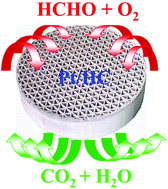Efficient decomposition of formaldehyde at room temperature over Pt/honeycomb ceramics with ultra-low Pt content
Abstract
Pt/honeycomb ceramic (Pt/HC) catalysts with ultra-low Pt content (0.005–0.055 wt%) were for the first time prepared by an impregnation of honeycomb ceramics with Pt precursor and NaBH4-reduction combined method. The microstructures, morphologies and textural properties of the resulting samples were characterized by X-ray diffraction (XRD), field-emission scanning electron microscopy (FE-SEM), and transmission electron microscopy (TEM). The obtained Pt/HC catalysts were used for catalytic oxidative decomposition of formaldehyde (HCHO) at room temperature. It was found that the as-prepared Pt/HC catalysts can efficiently decompose HCHO in air into CO2 and H2O at room temperature. The catalytic activity of the Pt/HC catalysts increases with increasing the Pt loading in the range of 0.005–0.013 wt%, and the further increase of the Pt loading does not obviously improve catalytic activity. From the viewpoint of cost and catalytic performance, 0.013 wt% Pt loading is the optimal Pt loading amount, and the Pt/HC catalyst with 0.013 wt% Pt loading also exhibited good catalytic stability. Considering practical applications, this work will provide new insights into the low-cost and large-scale fabrication of advanced catalytic materials for indoor air purification.


 Please wait while we load your content...
Please wait while we load your content...